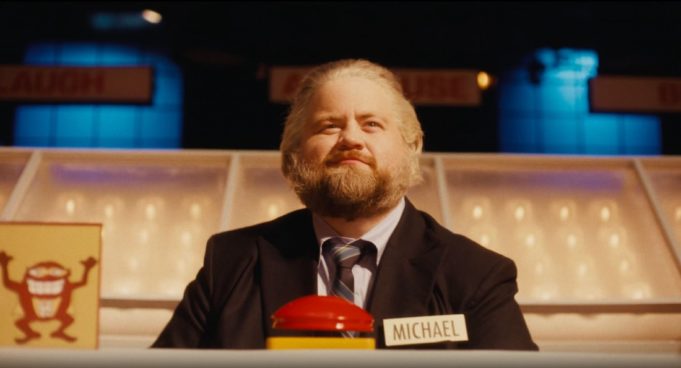The odd historical drama The Luckiest Man in America takes place on the TV game show Press Your Luck. The original version of that show went off the air in 1986, but luckily, I caught a few episodes back then as a little kid, so I can break it down for you. Contestants would answer trivia questions for spins of the board, and stop the board by pushing down a plunger in front of them. The show’s board was a square made up of 18 miniature squares, which would light up randomly while the content of the squares would also shift at random. When a contestant stopped the board, they won the prize in the lit-up square. Most of the prizes were cash, while some were merchandise, but sometimes a player would land on a “whammy,” which would lose them everything they had won and trigger an animation of a little red demon called the whammy taking their money. The cash prizes always came with an additional spin, so one player could theoretically win forever on a single spin.
The movie doesn’t give us any backstory. It just opens with A/C repairman and sometime ice-cream truck driver Michael Larson (Hauser) showing up at CBS’ Television City headquarters in Hollywood in 1984 and pretending to be someone else to get an audition for the game show. He’s found out, but showrunner Bill Carruthers (David Strathairn) decides that this hayseed who drove his ice-cream truck from Lebanon, Ohio all the way to California needs to be on TV. The studio audience will root for this guy who doesn’t know how to address the camera and has a two-tone head, with white hair on his scalp and dark hair in his beard. Once Michael starts playing, he keeps spinning and picking up prizes without hitting a whammy, and Bill goes from rooting for him to pulling aside Press Your Luck host Peter Tomarken (Walton Goggins) and ordering him to stop the run by any means.
Larson wasn’t lucky, nor was he cheating. He had just figured out a flaw in the game. The random lighting up of squares wasn’t random at all, but rather moved predictably in five distinct patterns. (That’s right, only five. Carruthers and his team should have invented more patterns instead of spending their creative energies thinking of different animations for the whammy.) Larson memorized all five of the patterns, so once the board got moving and he got a feel for which one it was using, he could hit his plunger at the right moment to avoid the whammy and hit the highest-value squares. He wound up winning more than $110,000 — since you’re wondering, that equals three times as much in today’s money — which was more than any game-show contestant had won before. The movie departs from real life in one large instance: The showrunners didn’t throw off Larson by calling up his unimpressed ex-wife (Haley Bennett) and putting her voice on the air. Larson ended his own win streak because he was growing mentally fatigued.
The movie doesn’t have much of a viewpoint on its story other than “That’s crazy!” One of the film’s producers is Elizabeth Banks, who just happens to host the new version of Press Your Luck that’s currently running on ABC, which is probably why this movie exists in the first place. The stacked supporting cast (Maisie Williams, Shamier Anderson, Brian Geraghty, Patti Harrison, Johnny Knoxville) doesn’t register, and Goggins is too odd and distinctive a presence to play Tomarken. The post-credit sequence contains a clip from the 1980s show, so you can compare.
You can also compare the way Hauser imitates Larson’s upspeaking manner of speech. This actor keeps playing rubes who think they’re smarter than the educated city folk around them, and whether they’re right (Richard Jewell) or dead wrong (I, Tonya), you can’t take your eyes off his characters as you watch him navigate the world. Here he plays a guy whose lopsided brain makes him good at only one thing, and he finds a way to make the most of it. He’s the reason to see this film, as he continues to carve out a unique niche in American movies.
The Luckiest Man in America
Starring Paul Rudd and Jenna Ortega. Written and directed by Alex Scharfman. Rated R.













